This Garlic Shrimp Pasta combines tender sautéed shrimp with a lemony white wine sauce and al dente spaghetti. This comes together in just 30 minutes with simple ingredients and fresh seafood. It’s a family-friendly dinner that feels fancy but couldn’t be easier to make. Perfect for both weeknights and romantic date nights.
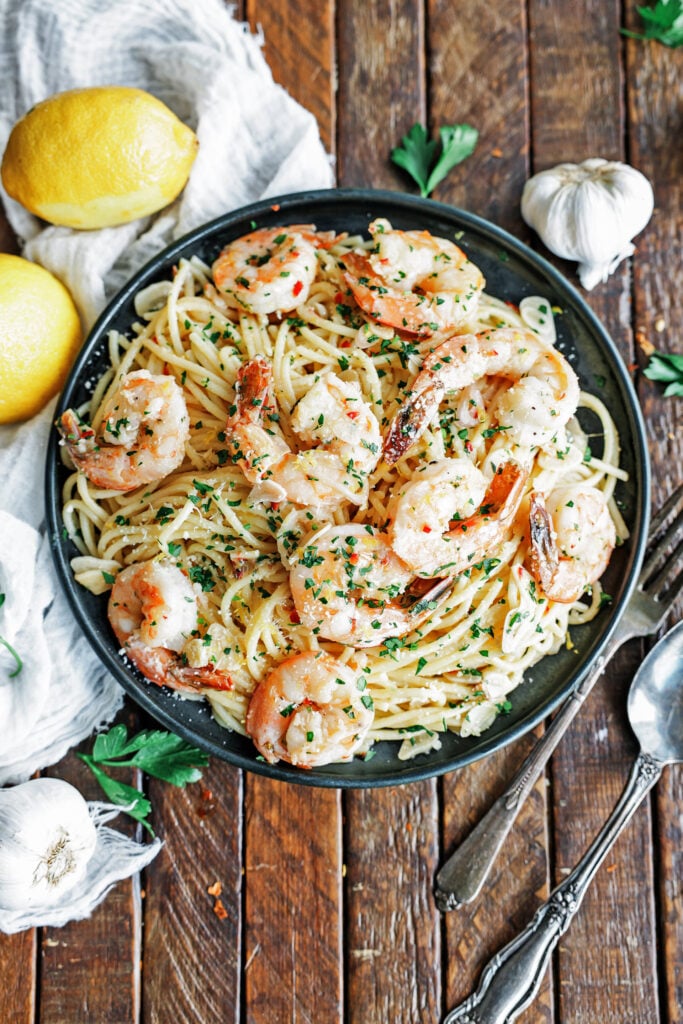
Fresh seafood is a family favorite in our house, and the easier it is to cook, the better. Shrimp is usually my first pick because it takes seconds to cook and goes well with almost any flavor. If you’re a fellow fuss-free seafood fan, then you should try my Easy Shrimp Cocktail and Shrimp Fra Diavolo recipes.
Lemon Garlic Shrimp Pasta Recipe
This garlic shrimp pasta has a lot in common with shrimp scampi. Sear the shrimp in a hot pan with oil, then tuck it into a vibrant lemon garlic sauce and toss with spaghetti. It has the same garlicky, lemony white wine magic you’d expect from classic shrimp scampi, but with slightly more luxurious qualities thanks to melted butter and Parmigiano Reggiano cheese.
One of my favorite things about this seafood pasta dinner is its versatility. It’s comforting and filling when served all on its own but goes well with a side of crusty bread, green salad, or roasted vegetables. The flavors are fun to play with, too. I like adding Fresno peppers for a touch of heat, but they can easily be left out or replaced with another pop of flavor. No matter the spin you put on this dish, you’re always left with a filling meal that’s bright, savory, and perfectly balanced.
Ingredients and Substitutions
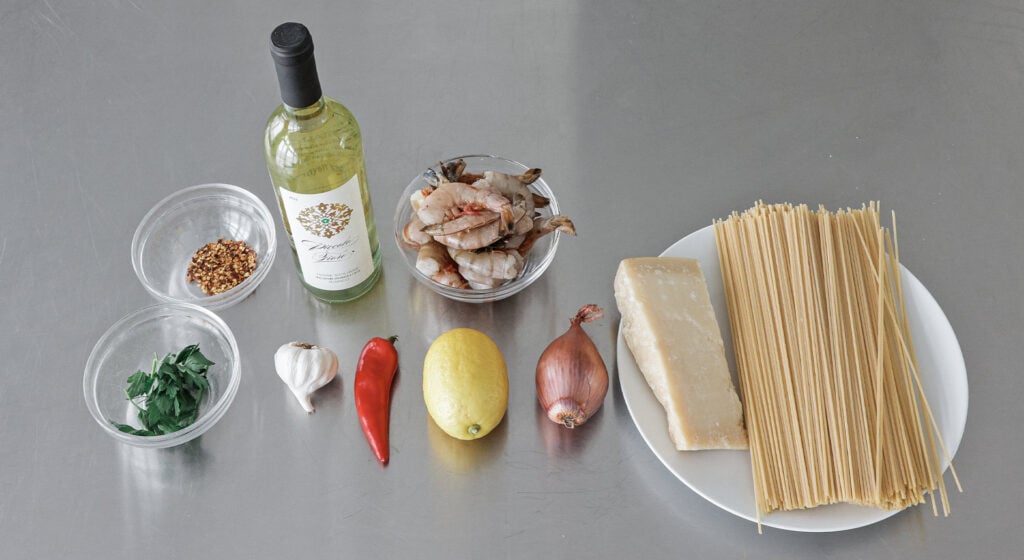
- Pasta – Spaghetti is my first choice for soaking up the buttery garlic sauce. You can also use any long, twirlable pasta, such as linguine, fettuccine, or angel hair.
- Oil – I seared the shrimp and aromatics in olive oil. Any high-heat oil, like avocado oil, will work as a substitute.
- Shrimp – I use fresh, peeled, and deveined 16/20 shrimp. Frozen shrimp also works. I recommend thawing them in the fridge overnight and patting them dry before cooking.
- Aromatics – Sautéed garlic cloves, a shallot, and a Fresno pepper are the backbone of the sauce. If you can’t find Fresno peppers, use red pepper flakes instead.
- Lemon – I used freshly squeezed lemon juice in the sauce and lemon zest as a garnish.
- Wine – I find that a dry white wine, like Sauvignon Blanc or Pinot Grigio, adds a well-balanced acidity and complexity to the sauce. If you’d rather skip the wine, you can substitute chicken or vegetable broth along with an extra squeeze of lemon juice.
- Butter – Unsalted butter is usually what I use in cooking because it gives me more control over the sodium content.
- Cheese – I like grated Parmigiano Reggiano in the sauce. Pecorino Romano also works if you want a sharper flavor.
- Herbs – Just fresh parsley.
- Seasonings – Salt and pepper.
How to Make Garlic Shrimp Pasta
Boil the pasta: First, I bring a large pot of salted water to a boil. Then I cook the pasta according to the package instructions.
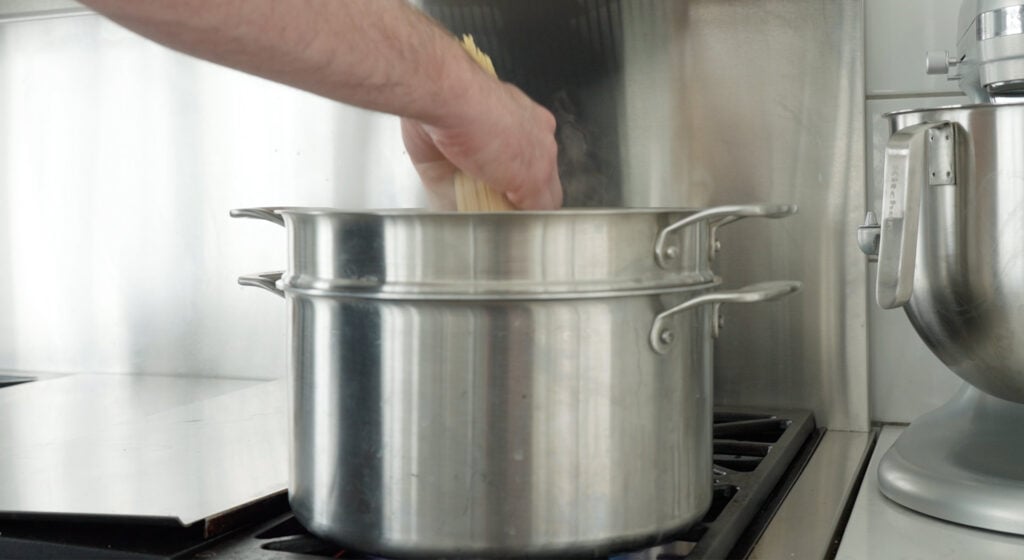
Sear the shrimp: In a large sauté pan, I heat some olive oil over medium heat. I place the shrimp in the hot pan and season them with salt and pepper. I sauté them for no more than 90 seconds, then transfer them to a plate and set them aside.
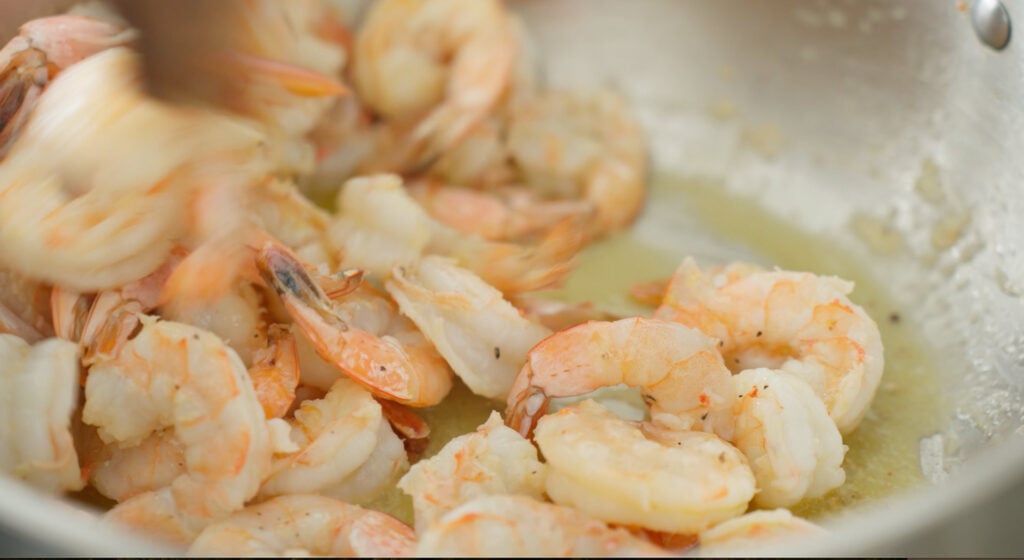
Sauté the aromatics: I heat the remaining olive oil in the now-empty pan over medium heat. Once hot, I sauté the garlic, shallots, Fresno pepper, and a pinch of salt until the aromatics begin to brown.
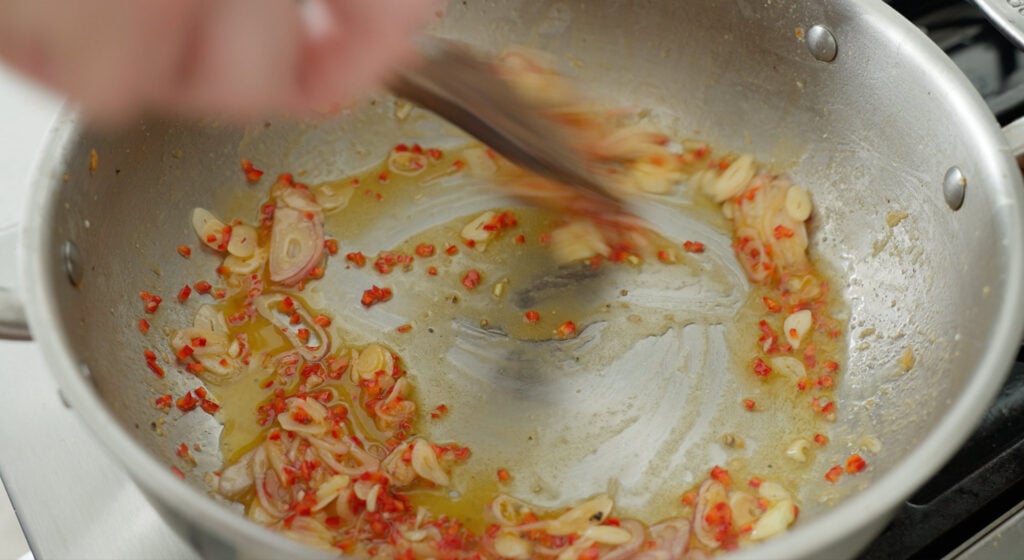
Build the flavors: Next, I squeeze in the juice of half a lemon, then deglaze the pan with the wine. I let it simmer until the liquid reduces and I’m left with about 3/4 cup in the pan.

Finish the sauce: Next, I add some of the reserved pasta cooking water and the butter. Once the butter is melted into the sauce, I strain the cooked pasta and add it to the pan with the sauce. I sprinkle Parmigiano over the top and mix until the pasta is well-coated.
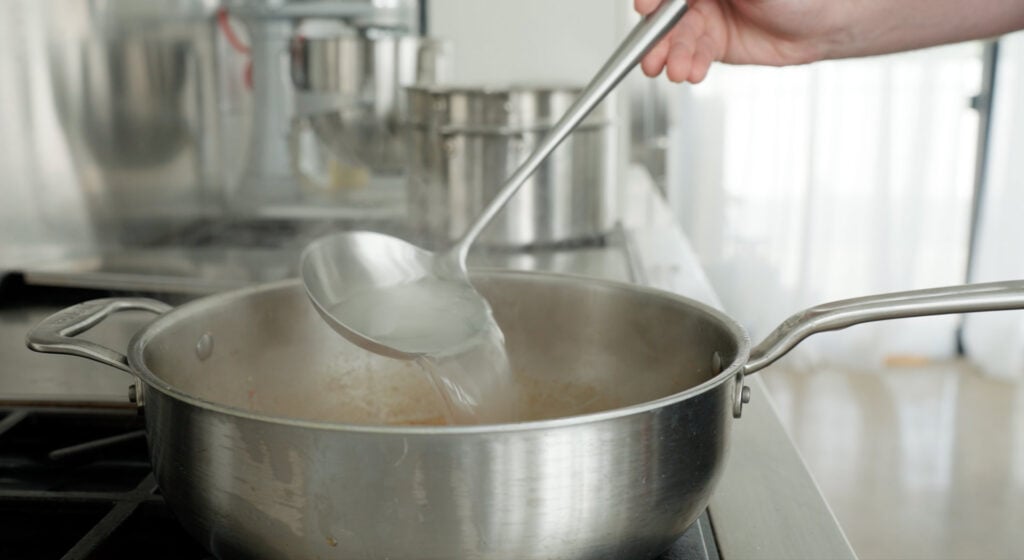
Add the shrimp: I fold the shrimp back into the pan, along with the chopped parsley, and stir just until everything is warmed through and well combined.
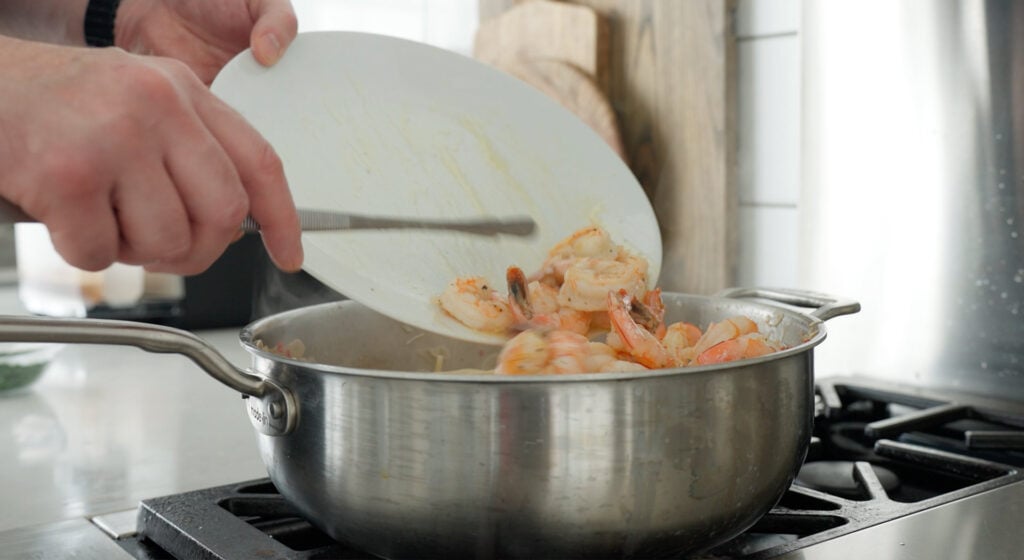
Garnish and serve: I divide the pasta into bowls and garnish each serving with more fresh parsley, the zest of half a lemon, and the juice from the remaining half.


Chef Tip + Notes
What matters most to the quality of your dish is perfectly cooked shrimp. It typically only takes me around 90 seconds to sear the shrimp in a hot pan, or until I see that they’ve curled into a loose “C” shape and have turned just barely opaque. If you cook the shrimp past this point, they will likely go from tender to rubbery and chewy.
- Pat the shrimp dry before cooking: Excess moisture is the enemy of a good sear. Use a paper towel to blot the shrimp dry before adding them to the pan to encourage them to brown instead of steam.
- Sear shrimp in a single layer: For the best texture and flavor, don’t overcrowd the pan. Sear the shrimp in a single layer so they cook evenly and develop a golden color.
- Don’t rinse your pasta: After cooking, the pasta will be covered in a surface layer of starch, which helps the sauce cling to each strand. Just drain the al dente pasta and dump it straight into the pan with the sauce.
- Customize this recipe: This garlic shrimp pasta recipe is very flexible. There’s room for vegetables, like sautéed cherry tomatoes, mushrooms, or leafy greens. You can also swap the shrimp for pan-seared scallops. Or, for a slightly richer meal that’s similar to shrimp scampi or alfredo, stir in a splash of heavy cream or a dollop of mascarpone cheese at the end.
Serving Suggestions
When I’m making this shrimp pasta for everyday dinners, I’ll serve it with a fresh salad, like a simple Italian salad or a classic Caesar. The pasta is quite filling on its own, but a side of garlic bread or roasted asparagus never hurts.
This dish is always a hit at dinner parties, too. I like to start with Italian-inspired appetizers, like marinated olives, bruschetta, or mussels in garlic wine broth, before bringing out the pasta. It makes the meal feel extra special.
Storage
How to Store: Pack the leftovers into an airtight container and store them in the refrigerator for up to 2 days.
How to Reheat: Reheat the leftovers in a saucepan on the stove over medium heat. Add a splash of water or broth to loosen the sauce, if needed. Be careful not to overheat the shrimp or else they will become rubbery.
More Pasta Recipes

Video
Garlic Shrimp Pasta
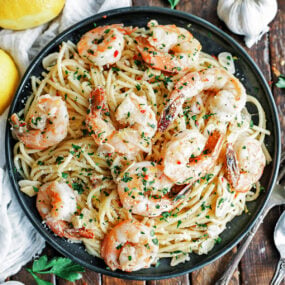
Ingredients
- 1 pound of dry spaghetti pasta
- 5 tablespoons olive oil
- 2 pounds peeled and deveined 16/20 shrimp
- 6 thinly sliced garlic cloves
- 1 peeled small-diced shallot
- 1 seeded small-diced Fresno pepper, sub 1 to 2 teaspoons of pepper flakes
- juice of 1 lemon
- 1 cup dry white wine
- 4 tablespoons unsalted butter
- 1 cup grated Parmigiano Reggiano
- ¼ cup finely minced fresh parsley
- Zest of ½ lemon
- coarse salt and freshly cracked pepper to taste
Instructions
- Add the pasta to a large pot of boiling salted water and cook it according to the package instructions. For spaghetti, it’s roughly 8 to 10 minutes. Be sure to come back every few minutes to stir everything.
- In the meantime, add 4 tablespoons of olive oil to a medium to large-sized saucepan over medium heat. After one minute of heating, add in the shrimp, spread them around the pan, and season with salt and pepper.
- Saute for no more than 90 seconds, it’s ok if they’re just a bit underdone. Set them to the side and then return the pan over medium heat and add in the remaining 1 tablespoons of olive oil.
- Add in the garlic, shallots, and Fresno pepper, and gently season with salt and sauté for 45 to 60 seconds. Everything should start to very gently brown.
- Squeeze in the juice of ½ lemon and then deglaze with the white wine and cook until only about ¾ cup of liquid remains. This will only take 2 to 3 minutes.
- Next, add 1 to 1 ½ cups of the pasta water to the pan along with the butter. As soon as the butter is melted, the pasta should be done. Strain it and add it to the pan along with the Parmigiano and mix until everything is thoroughly coated.
- Next, fold in the shrimp and parsley and mix until combined.
- Serve with an additional garnish of minced parsley, the zest of ½ lemon, and the final juice of ½ lemon.

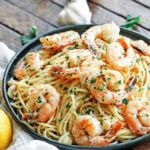
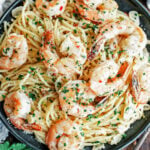
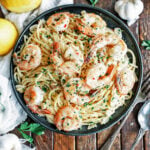
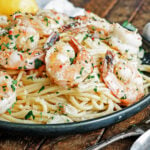
Super easy to cook and very quick for busy nights! Was absolutely delishes. Is the nutrition facts per serving or for all 4 servings together?
It’s per serving. So glad you enjoyed it!
This is a great dish! Cooked with Orzo pasta, added some heavy whipping cream at the end. Used Greek Olive Oil from local store Niche. This is EXCELLENT. Restaurant quality recipie. Will make again…Often!
Thanks for giving it a shot!